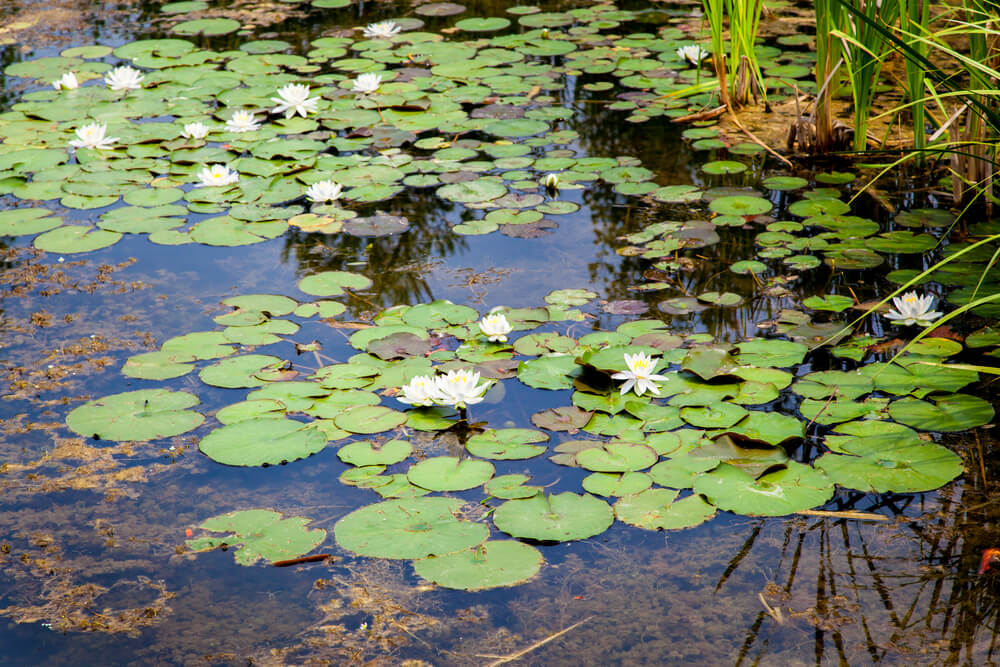Water lilies are one of the most beautiful additions to any sort of pond/water feature (which usually go well with pond fountains), but in order for them to keep their beauty, they need to be cared for.
Additionally, water lilies help in ponds by preventing algae growth and providing shade for any fish dwelling in the water.
Having said that, they can also be grown in big pots or stock tanks if there isn’t a nearby pond.
Although they are gorgeous flowers, they require a lot of energy and care in order to give them the strongest chance of growing healthy.
Before growing water lilies, it helps to already know some methods that will give them their best chance to survive, no matter the time of year.
This article will go over some main information necessary for growing and tending water lilies, so make sure to check through this list before adding these flowers to any decor.
CHOOSING A LILY
Before continuing any further through this article, one of the most important things that must be done is first choose which type of lily to work with. Typically, water lilies can be separated into two categories: hardy lilies and tropical lilies.
Hardy lilies are, as the name implies, known for their resilience, tenacity, and ability to survive in more varied temperatures.
These are the lilies that are best used in colder climates and places that see snow.
As long as the water surrounding the roots doesn’t freeze (even if the water above the roots does freeze), the lily will survive through the colder months.
Tropical lilies, on the other hand, are much more temperamental and delicate when it comes to climate changes.
As such, they will not survive outside in the winter and will need to be brought inside as the temperature dips and be provided with additional care during the colder months.
CHOOSING A POT, SOIL, AND FERTILIZER
Choosing the correct pot, soil, and fertilizer can keep the pond clean, free of algae, and free of sickness or rot.
Proper research is required to make sure the water lilies have the best chance of success.
When it comes to growing water lilies, they will grow to the size of the pot in which they’re planted.
However, a too-small pot will stunt the growth of the plant and harm its longevity. Many sites recommend starting with pots that are at least 12” in diameter.
Whichever pot has been chosen, the next step is to fill it with soil and fertilizer. For soil, most experts recommend heavy, bagged garden soil.
Some recommend pea stones or kitty litter, but it is actually better to avoid these types because they can leech fertilizer into the water (which will increase the possibility of algae growth in the water) and prevent the lily from getting proper nutrients.
As for fertilizer, water lilies are very heavy feeders.
The best time to fertilize them is early in the spring using specific types of aquatic plant fertilizers.
All fertilizers will have three numbers on the outside of their labels, and it is best to choose fertilizers that have a higher middle number (i.e., 12-17-17).
The higher middle number is an indicator of how much phosphorus is in the fertilizer, and this chemical is important for creating beautiful and healthy flowers within the water lily.
PLANTING THE LILY
First, fill the chosen pot about ⅓ high with the chosen soil. Next comes the fertilizer, which should be added to the pot-and-soil combination as per the directions on the purchased fertilizer.
Remove the water lily from whatever temporary pot it has been initially placed within and move it to the new pot; make sure to place the water lily's roots gently at the bottom of the pot.
It is important to then position the water lily’s growing tip aiming at the pot’s center and pointing upward at a 45° angle so that it can grow into the pot and have the most room to stretch.
Fill the pot to about ¾ high (without crushing any parts of the water lily) and gently pack the dirt around the roots, leaves, or growing tip.
If the plan is to put the water lily inside a pond or a location with fish, fill the remaining ¼ area with gravel so that the small aquatic creatures won’t be able to release the soil and fertilizer.
If the soil and fertilizer are released and interact with the pond water, it can increase the growth of algae in the water. It’s best to make sure that the distance between the pot’s top and the water surface is less than 24”.
TEMPERATURE
The temperature of the water is the largest determinant for whether a water lily will survive through the winter/colder months.
For tropical lilies, it’s best to keep them as close to a constant temperature of 68°F as possible.
Whether that means storing the tropical water lily in a greenhouse, a heated aquarium, or in a temperature-controlled room under green lights, keeping the tropical variety of this plant alive requires additional maintenance.
As for the hardy strain of this plant, hardy water lilies actually seem to thrive if left alone in the winter months—so long as the plant remains in a section of water that will not freeze.
The plant can either be submerged in a deeper part of the pond (a part that does not freeze) or brought inside and placed in a room that stays around 50°F.
CONCLUSION
Whether the plan is to focus on tropical water lilies or on hardy water lilies, caring for these plants requires a lot of preparation and care.
Doing research and making sure to prepare for how the plant will be cared for in the winter are some of the best ways to make sure that whichever water lily is being grown will have its strongest chance of survival.
